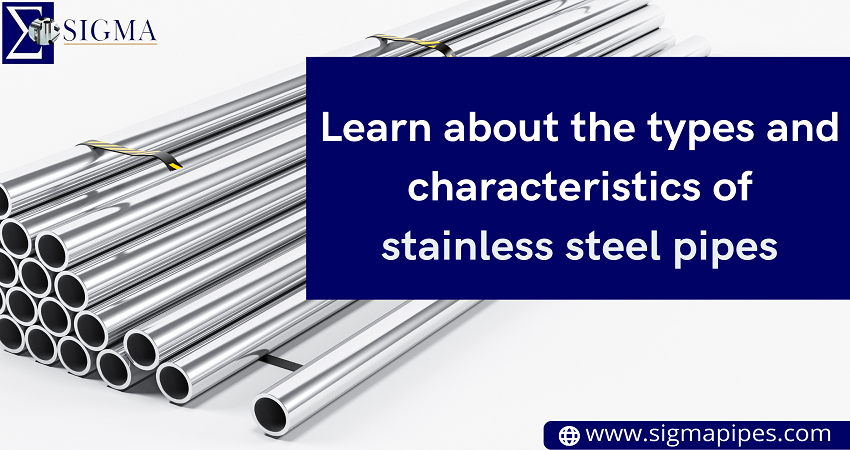Stainless steel has become the most popular and widely used material in the world since it was developed over a century ago. Stainless steel has an exceptional corrosion resistance that helps increase features with chromium content. As well as being resistant to pitting attacks in chloride solutions, the material is also resistant to reducing acids. For SS pipes, it is ideal and best as it requires minimal maintenance, and it is familiar to luster.
Various industries rely on this versatile material. In particular, SS pipes can benefit from this application. Seamless and welded stainless steel pipes are available in different types. Different industries can use it due to its varied composition. Regular use of stainless steel square bar is prevalent in general industrial companies.
Types of SS pipes
Here are some examples of stainless steel pipes used in various scenarios:
Seamless Pipe
Seamless pipes do not have any weld joints or seams. Despite extreme temperatures and pressure, it can withstand them. A comprehensive range of applications is possible with seamless pipes, such as gas and oil. Mechanical and engineering industries also use them. Furthermore, before delivery to the client, it is inspected at a precision level to ensure high quality.
Welded Pipe
Due to their flexibility, welded pipes are used almost everywhere. The cost is higher when it comes to corrosion resistance, thus opposing pressure. Due to the type of material used, welded pipes are lightweight. They are more cost-effective than other piping methods.
Pipe Flanges
Pipe flanges are also essential parts of piping systems. In addition to threaded flanges, semi-flanges, lap joints, and blind flanges are available. Material and durability ensure high-quality products with utmost reliability.
Read More – Checklist Of Things To Look For In Steel Bars Suppliers
Characteristics
Corrosion Resistance
Most stainless steel pipes available on the market are iron-based alloys with a minimum chromium content of 10.5%. Chromium forms a protective oxide layer on the alloy. Oxide layers formed on stainless steel pipes give them corrosion resistance. Self-healing oxide layers guarantee intact corrosion resistance regardless of fabrication methods.
In different environments, corrosion resistance may work differently depending on the grade of stainless steel pipe. There are two main characteristics of stainless steel pipes- they are resistant and contain chromium, which makes them resistant to attack.
Cryogenic Resistance (low temperature)-
Toughness or ductility is an indicator of low-temperature cryogenic resistance. The tensile strength of rectangle stainless steel increases dramatically at cryogenic temperatures. In harsh environments, they also maintain excellent toughness. Steel pipes that are precipitation hardening, martensitic, or ferritic have no use for subzero temperatures. Low temperatures significantly reduce grade toughness. In some cases, the cryogenic resistance drops below atmospheric temperatures.
Work Hardening
Work hardening increases and enhances mental strength significantly and helps achieve cold working in stainless steel square bars. Combining annealing with cold working provides the appropriate strength to the fabricated components.
Hot Strength
It is possible to retain high strength at peak or elevated temperatures. High chromium or silicon content in stainless steel pipe grades is responsible for its hot strength. For chromium ferritic grades, high hot strength is possible.
High-chromium stainless steel pipes resist scaling at high temperatures.
Strength and Formability
Different grades of stainless steel pipe offer different strengths. In soft conditions, strength remains somewhat constant compared to mild strength. Ferritic stainless steel pipes offer good elasticity and strength. The subsequent heat treatment gives martensitic square stainless steel pipes their hardness and strength.
Ductility
In tensile tests, % elongation determines ductility. Austenitic stainless steel has high elongation. In deep drawing, austenitic stainless steel can form and work because of its high work hardening and ductility.
High Strength
Stainless steel has a higher tensile strength than mild steel. In general, duplex stainless steel has a higher quality than austenitic steel. Tensile strength is highest among martensitic and precipitation-hardening grades. The strength of these grades is double that of other grades.
Magnetic Response
In general, stainless steel responds to magnetic fields. In several austenitic grades, cold working can induce magnetic behavior. Cold-worked grades like 316 and 310 are usually non-magnetic. Magnetism is present in all other grades of stainless steel.













